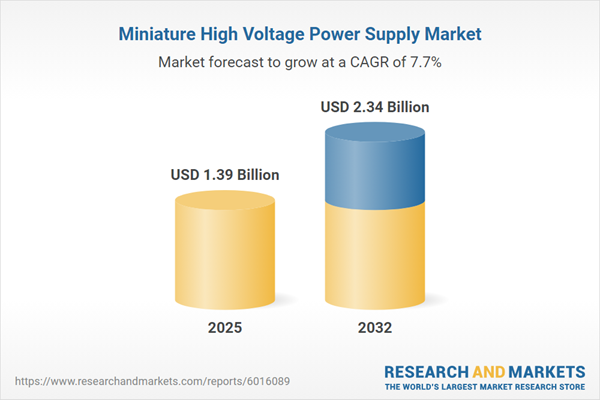Speak directly to the analyst to clarify any post sales queries you may have.
The miniature high voltage power supply market is rapidly evolving, driven by advancements in miniaturization, increasing demands for reliability, and progression in digital applications across sectors. Senior leaders require actionable intelligence to make strategic investment and procurement decisions in this dynamic sector.
Market Snapshot: Miniature High Voltage Power Supply Market
The Miniature High Voltage Power Supply Market grew from USD 1.29 billion in 2024 to USD 1.39 billion in 2025. It is expected to continue growing at a CAGR of 7.68%, reaching USD 2.34 billion by 2032.
This rapid expansion is a result of enhanced semiconductor innovation, adoption of modular and scalable architectures, and heightened demand for smart, ultra-compact solutions in sectors such as medical imaging, aerospace, and advanced electronics. Shift toward integrated electronic systems and evolving regulatory standards further underpin ongoing growth and market transformation.
Scope & Segmentation
- Product Type: AC-DC power supply, DC-DC converter power supply
- Power Capacity: 1000-4000V, below 1000V, above 4000V
- Output Type: Adjustable output high voltage, fixed output high voltage
- Cooling Technology: Air-cooled, liquid-cooled
- End-User: Aerospace and defense, automotive, healthcare, semiconductor and electronics, telecommunications
- Distribution Channel: Offline, online
- Regional Coverage: Americas (North America, Latin America), Europe, Middle East, Africa, Asia-Pacific
- Key Companies Analyzed: ABB Ltd., Advanced Energy Industries Inc., American High Voltage, American Power Design Inc., Analog Technologies Inc., Applied Kilovolts Ltd., Crane Aerospace & Electronics, CUI Inc., Dean Technology Inc., Excelitas Technologies Corp., GE Vernova Group, Hamamatsu Photonics K.K., HVM Technology Inc., Infineon Technologies AG, IONICS, Matsusada Precision Inc., Murata Manufacturing Co. Ltd., Shaanxi Wisman High Voltage Power Supply Co. LTD., Siemens AG, Spellman High Voltage Electronics Corporation, TDK Corporation, Toshiba Corp., XP Power Limited
Key Takeaways for Senior Decision-Makers
- Miniaturization of high voltage power supplies is shaping engineering approaches, driving higher voltage densities while maintaining performance and compatibility.
- Integration of smart monitoring and embedded diagnostics is enabling real-time predictive maintenance, enhancing equipment reliability, and optimizing supply chain responsiveness in mission-critical applications.
- Regulatory pressure is compelling adoption of modular architectures and scalable systems, streamlining certification while promoting faster product customization.
- Cross-sector collaboration is accelerating technology iterations, uniting designers and end users to respond to shifting market requirements and emerging use cases.
- Regional variations dictate priorities—North America leads in aerospace and medical applications, Europe emphasizes strict safety compliance, and Asia-Pacific is a hub for applications in electronics and telecommunications fueled by cost efficiency and R&D cooperation.
Tariff Impact and Supply Chain Adjustments
Recent US tariffs on critical power supply components have prompted manufacturers to diversify sourcing strategies, enhance lean production, and forge stronger partnerships with local suppliers. This shift promotes operational resilience and limits exposure to international cost fluctuations. Efficiency initiatives and supply chain geographic diversification are now central to mitigating cost pressures and maintaining consistent module quality.
Methodology & Data Sources
This report employs a two-pronged research framework. Extensive secondary research covered technical literature, patents, and industry standards to map solutions and regulatory influences. Primary research included interviews with engineers, procurement leaders, and end users across major demand verticals, ensuring market insights align with real-world application demands. Data triangulation cross-verified strategic findings, reinforcing accuracy and reliability.
Why This Report Matters
- Provides comprehensive segmentation and analysis for optimized product development aligned with precise end-use and market trends.
- Clarifies challenges and responses to recent component tariffs, offering strategic guidance for supply chain and procurement planning.
- Equips leaders with actionable takeaways on technology trends, regulatory shifts, and regional drivers for informed, future-proof decision-making.
Conclusion
This executive summary delivers essential insights to guide strategic positioning in the miniature high voltage power supply market. Organizations aligning innovation, supply chain agility, and customer collaboration are best positioned to leverage evolving opportunities.
Additional Product Information:
- Purchase of this report includes 1 year online access with quarterly updates.
- This report can be updated on request. Please contact our Customer Experience team using the Ask a Question widget on our website.
Table of Contents
3. Executive Summary
4. Market Overview
7. Cumulative Impact of Artificial Intelligence 2025
Companies Mentioned
The companies profiled in this Miniature High Voltage Power Supply market report include:- ABB Ltd.
- Advanced Energy Industries, Inc.
- American High Voltage
- American Power Design, Inc.
- Analog Technologies, Inc.
- Applied Kilovolts Ltd.
- Crane Aerospace & Electronics
- CUI Inc.
- Dean Technology, Inc.
- Excelitas Technologies Corp.
- GE Vernova Group
- Hamamatsu Photonics K.K.
- HVM Technology, Inc.
- Infineon Technologies AG
- IONICS
- Matsusada Precision Inc.
- Murata Manufacturing Co., Ltd.
- Shaanxi Wisman High Voltage Power Supply Co.,LTD.
- Siemens AG
- Spellman High Voltage Electronics Corporation
- TDK Corporation
- Toshiba Corp.
- XP Power Limited
Table Information
| Report Attribute | Details |
|---|---|
| No. of Pages | 186 |
| Published | November 2025 |
| Forecast Period | 2025 - 2032 |
| Estimated Market Value ( USD | $ 1.39 Billion |
| Forecasted Market Value ( USD | $ 2.34 Billion |
| Compound Annual Growth Rate | 7.6% |
| Regions Covered | Global |
| No. of Companies Mentioned | 24 |









